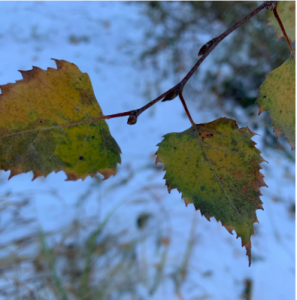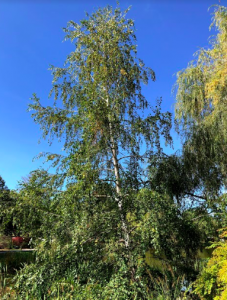River Birch
Betula nigra | Family: Betulaceae
Submission: Olivia LaMarche ’20 and Saylor Strugar ’21
Leaves – 2-5”; ovate with a broad cuneate base; deeply doubly serrate.
Twigs – Slender, more or less pubescent, non-aromatic; buds acute.
Fruit – Cylindrical, erect, matures in late spring.
Bark – Salmon-pink; thin, papery strips, becoming scaly.
Natural History:
Walking along the banks of a river, through a young forest, or along a city street, there is a tree that stands out from the rest. At first glance it might appear to be just another paper birch, but the salmon-pink bark hidden under the peeling, silver outer layer is a unique, sought after characteristic of the river birch (Betula nigra). It is the southernmost species of the 60 birches and can be found growing naturally across much of the United States from Minnesota and New Hampshire to Florida and Texas. Mature river birch are typically multi-stemmed and range from 40 to 90 feet tall. Their relatively fast growth rate supports their need for nearly full sun. Stretching high above the forest floor, the canopy is characterized by deeply toothed leaves and green or brown catkins paired with small nutlets.
Another remarkable characteristic of river birch is their hardiness and adaptability. Unlike most trees, they thrive in acidic soils. They can also grow in a wide range of environments including well drained soil, wet soil, and clay. This tree is resistant to drought, flooding, and air pollution. In addition to their environmental versatility, river birch is the only birch species that is resistant to the Birch Borer, an extremely harmful disease that leads to mortality in birch populations. The beauty, hardiness, and resiliency of river birch contributes to their popularity and many varied ecological and economic uses.
River birch found on river and stream banks are not only a pleasant sight, but they also prevent erosion due to their strong roots. They are used to recover areas of high soil acidity caused by mining because of their ability to grow in acidic soils. River birch support a wide variety of wildlife as deer and other browsers feed on the foliage, songbirds feast on the small but plentiful seeds, and ruby-throated hummingbirds drink the sap.
 A unique feature of birch trees are the oils that make the bark both flammable and waterproof. The bark can be used as a fire starter to kick-start a night of s’mores around the campfire, or come in handy as waterproof paper. According to Thomas Jefferson, birch bark is the best for taking field notes in wet conditions. While river birch wood is hard, strong, and close-grained, it is too knotted to be used as lumber, and is instead used primarily for inexpensive furniture, toys, artificial limbs, and occasionally veneer. Given its aesthetically pleasant attributes and ability to resist pollution, flood, and drought, it is a common ornamental tree found in parks, yards and side streets. It even began growing in Central Park, earning it the title of “Urban Tree of the Year” by the Society of Municipal Arborists. It offers beautiful, bright yellow leaves in autumn and a showy silver and salmon trunk in the winter, adding to any landscape such as the Bates Campus.
A unique feature of birch trees are the oils that make the bark both flammable and waterproof. The bark can be used as a fire starter to kick-start a night of s’mores around the campfire, or come in handy as waterproof paper. According to Thomas Jefferson, birch bark is the best for taking field notes in wet conditions. While river birch wood is hard, strong, and close-grained, it is too knotted to be used as lumber, and is instead used primarily for inexpensive furniture, toys, artificial limbs, and occasionally veneer. Given its aesthetically pleasant attributes and ability to resist pollution, flood, and drought, it is a common ornamental tree found in parks, yards and side streets. It even began growing in Central Park, earning it the title of “Urban Tree of the Year” by the Society of Municipal Arborists. It offers beautiful, bright yellow leaves in autumn and a showy silver and salmon trunk in the winter, adding to any landscape such as the Bates Campus.
References:
Arbor Day Foundation. River Birch Betula nigra. Accessed Nov. 13, 2019. https://www.arborday.org/trees/treeguide/TreeDetail.cfm?itemID=792
Clark, Karen. River Birch Tree Facts. Nov. 28, 2018. SFgate. Accessed Nov. 13, 2019. https://homeguides.sfgate.com/river-birch-tree-43016.html
Mcbrien, Tory. River Birch: Natural History and Other Important Characteristics. University of Vermont. Accessed Nov. 13, 2019. http://badger.uvm.edu/omeka/exhibits/show/uvmtrees/river-birch/river-birch-natural-hist
Missouri Botanical Garden. Betula nigra. Accessed Nov. 13, 2019. http://www.missouribotanicalgarden.org/PlantFinder/PlantFinderDetails.aspx?kempercode=x800
Sullivan, Janet. 1993. Betula nigra. In: Fire Effects Information System, [Online]. U.S. Department of Agriculture, Forest Service, Rocky Mountain Research Station, Fire Sciences Laboratory (Producer). Accessed Nov. 13, 2019. https://www.fs.fed.us/database/feis/plants/tree/betnig/all.html
